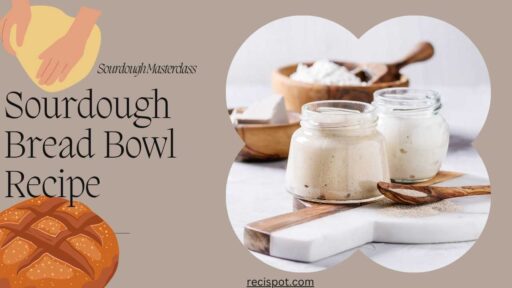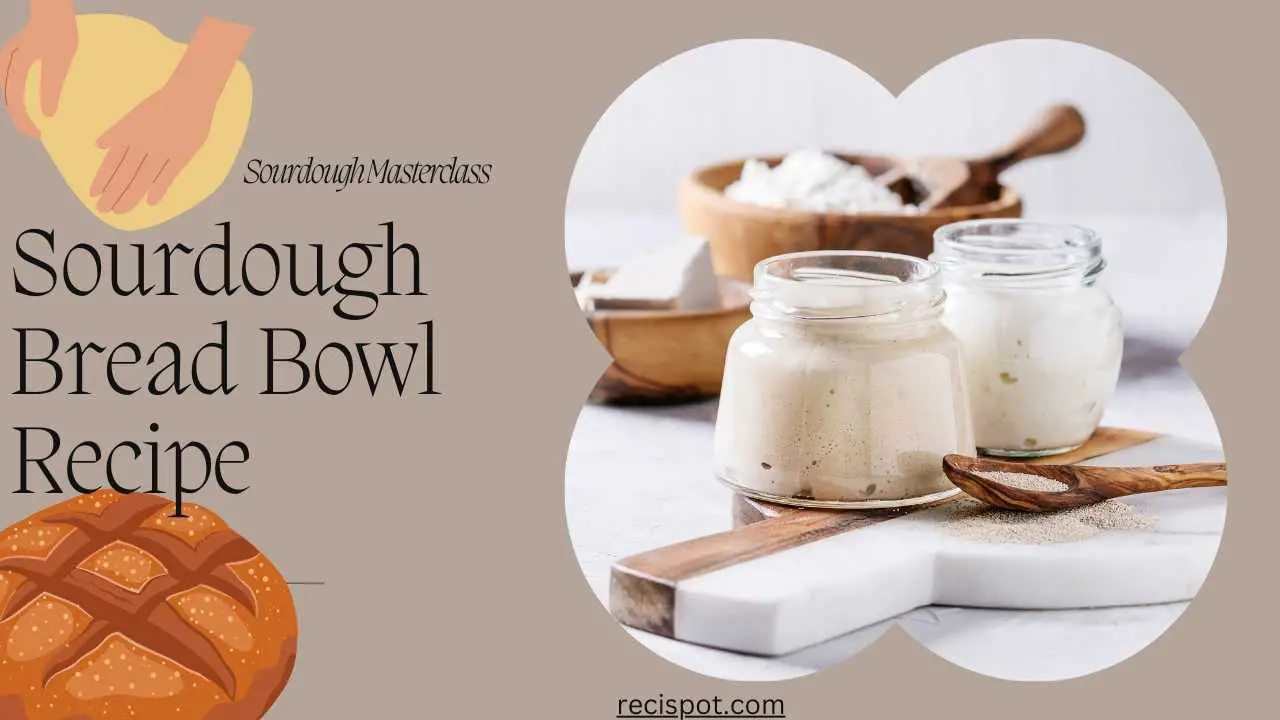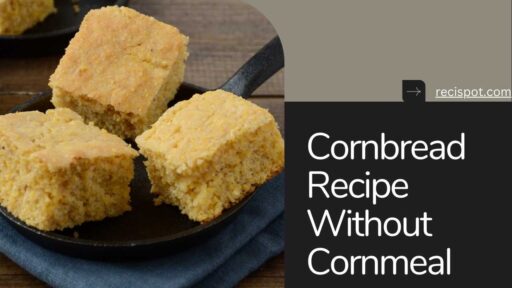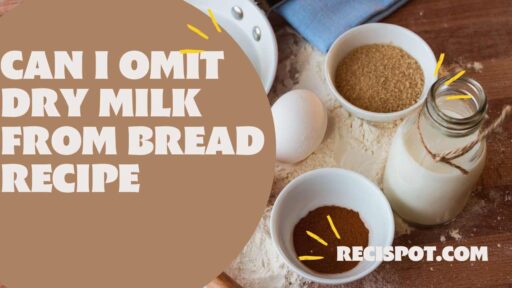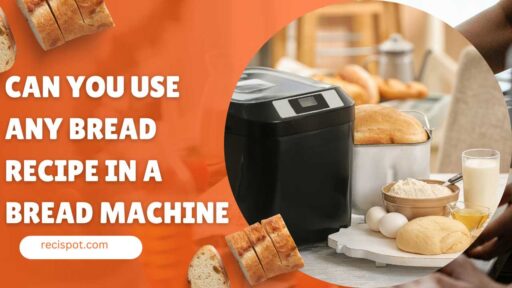Elevate your cooking skills with our Sourdough Bread Bowl Recipe. Impress your guests with a homemade bread bowl filled with your favorite soup or dip.
I find it uniquely satisfying to rip into the firm shell of a Sourdough Bread Bowl Recipe, revealing its spongy inner part, and then fill it with thick soup or stew. The experience is an amalgamation of freshly baked bread’s taste and a meal that nourishes it, making it one of the most delightful dishes in the culinary arts. In my case, the journey to baking sourdough bread bowls began as a mission to bring this artisanal experience into my kitchen. This journey has taken me on the path of not only mastering how to bake sourdough but also developing a deep appreciation for the history, techniques, and variations that define every single bread bowl.
Sourdough bread bowls are themselves empty canvases that can be filled with anything from classic clam chowder to more innovative modern recipes. What makes them so attractive isn’t just their ability to act as edible containers but instead the characteristic tangy flavor and texture of sourdough that gives each bite some depth. The perfect sourdough bread bowl recipe is about understanding sourdough culture, sourcing quality ingredients, and being patient while allowing flavors and textures to develop fully.
The History and Origins of Sourdough Bread Bowl Recipe
According to historians, the beginnings of sourdough go back for millennia in ancient Egypt, around 1500 BC. Sourdough was discovered by accident when natural yeasts fermented left-out dough in the air, making it rise lighter once baked. This serendipitous discovery marked the beginning of leavened bread baking, a practice that would spread across civilizations and continue to evolve over the centuries.
Sourdough Bread Bowl Recipe specifically have become popular recently, especially in San Francisco during the 1980s. San Francisco’s own signature sort-of-tangy-tasting sourdough was due to wild yeast strains present in its surroundings, unlike anywhere else on earth. It took off here in this culinary hotbed, serving clam chowder inside hollowed-out loaves made of sourdough, a tradition that came to define the innovative food scene in San Francisco.
The Benefits of Baking with Sourdough
Sourdough baking has numerous advantages ranging from nutritional to culinary. To begin with, the fermentation process involved in making sourdough bread results in a more digestible product. This is because lactic acid bacteria present in the starter breakdown gluten, hence bread made using commercial yeast holds back digestion for some people.
Additionally, sourdough fermentation also increases the availability of certain nutrients in the bread, such as B vitamins and minerals like magnesium and zinc, making it a healthier option. From a culinary perspective, sourdough bread boasts a complex flavor profile and a superior texture that commercial yeast breads struggle to match. During fermentation, acidity develops a subtly tangy taste, whereas the process itself contributes to chewiness and crust with delightful crisps, hence above all other types of yeasted loaves, even those produced commercially.
Understanding the Sourdough Bread-Making Process
The art and science of baking sourdough bread demands an understanding of fermentation and the ability to adapt to variables that can affect the outcome. At the center of sourdough baking is the starter – a living culture made up of flour, water, wild yeast and bacteria. To keep these organisms alive, feed the starter regularly.
Sourdough bread making involves combining more flour and water with the starter as well as any other ingredient before allowing it to ferment. This period is essential for development of flavor and texture in dough. Fermentation takes different lengths of time but generally longer fermentation makes for higher acidity and a more complex texture.
Materials Required for Making Sourdough Bread Bowls
To commence on your journey to make sourdough bread bowls, you need some basic ingredients plus tools. The ingredients are a healthy sourdough starter, good quality flour, water, and salt. Flour selection is important because it determines flavor characteristics, texture, structure, etc.; strong-bread flour with high protein content will give you a chew-like bread texture along with a crispy crust.
A digital weighing scale is indispensable when measuring ingredients accurately, among other tools required in the sourdough baking process. Precision is very important during sourdough baking; therefore, success depends on correct proportions. In addition, you also need a mixing bowl, a dough scraper, a proofing basket (or banneton), a sharp knife or lame to score the loaf prior to baking, as well as a Dutch oven or baking stone, which can simulate professional bakery ovens conditions resulting in perfect crusts.
Instructions for Creating Perfect Sourdough Bread Bowl
First prepare your active bubbly sour dough starter by feeding it 8-12 hours prior to starting on your dough plan. So once your starter has been prepared mix it with flour and water creating dough then add salt. Do remember Gluten needs developing through a series of folds whilst allowing fermentation.
After fermentation, divide the dough into rounds, shape them, and then let them proof in a well-floured banneton. Once proofed, carefully transfer the dough onto parchment paper, score the top to control the expansion, and then bake in a preheated Dutch oven or on a baking stone. For a crispy crust and soft, chewy interior, steam is required, so have a water pan under the oven or use a Dutch oven with a cover lid to create a steamy environment.
Step 1: Making the Sourdough Starter
Creating an Entirely New Starter
If you don’t already have a sourdough starter, you can make one by mixing together one part whole grain flour and one part water and letting it ferment at room temperature while feeding it daily. This process takes about five to seven days until you get a bubbly yeast mixture known as a sourdough starter.
Refreshing an Existing Starter
Refreshing an already existing starter is the first thing. Take some of the starter and feed it with flour and water, mixing nicely. It should double in size within 6-8 hours and have a sour smell to know it is ready.
Stage Two: Dough Preparation
Mixing Up
Put flour and water in one big bowl. Add a teaspoon of salt to enhance taste. Mix until you get a lumpy dough.
Fermentation Stage
Cover your dough with a cloth for about thirty minutes. This autolyze method will hydrate your flour and help you start developing the gluten without kneading.
Step Three: Kneading the Dough
The Art of Folding
Keep on folding or stretching out the dough so as to make it tighter. By so doing power will be developed without overworking it.
Checking for Gluten Development
After kneading has been done, pull off a small piece of dough that can be stretched until very thin, like a windowpane, without tearing apart. This shows that enough gluten has formed.
Step Four: Making Bread Bowl Shape
Cutting into Pieces and Molding The Bread Bowls
Make portions according to how many bread bowls you want to prepare out of this recipe. For each portion, fold its edges inside until smooth to achieve roundish boules (balls).
Second Rise or Proofing stage
Let the shaped loaves rest on a floured surface, seam-face down underneath, preferably kitchen towel cover them until they almost double their sizes during the second rise, which usually takes 2-4 hours.
Step Five: Baking Your Sourdough Bread Bowl
Preheat the Oven for the baking process
Set oven temperature at 450°F with appropriate baking surface such as pizza stone or cast iron dutch oven placed inside it.
Scoring Fermented Dough before Baking
Use a sharp blade to cut through the top parts of your unbaked loaves just before going into the oven. This makes them look attractive and helps them rise while baking in the oven.
The Steam Bath
Arrange your shaped loaves on this already heated stone or preheated Dutch oven then close the door of the oven immediately. Steam them by either spraying water into the oven or tossing few ice cubes into a cast-iron pan that has been preheated at the lower part of your oven. This will give you a crispy crust and promote an oven spring.
Time for Baking
Bake until deep golden brown crust is formed, and they sound hollow when thumped on their bottoms. It will last for about 30-40 minutes.
Step Six: Delivery & Safe Keeping
Ideal Number of Servings
Let the loaves cool after being baked for not less than 30 minutes. Cut each loaf’s upper part carefully so as to form a hole, which makes it a bread bowl where one can pour his/her favorite soup or dip.
Preservation Methods For Bread Bowl
Paper bag offers best crust if you still have some portions left. To make it last longer without drying out, place an onion that has been cut open in this bag with bread. For more prolonged storage, wrap it inside a kitchen towel then use aluminum foil paper to cover it outside. The taste might be different but also able to freeze such bread though its natural moisture along with crispiness are lost as well.
Step Seven: Variations on Tastes
Addition of Herbs and Spices
In addition to basic ingredients, consider adding one teaspoonful of dried herbs like rosemary or thyme when combining them all together.
Cheese Lover’s Twist
For a more lavish bread bowl, mix in a cup of your desired cheese; maybe sharp cheddar or Parmesan will do after kneading the dough.
Step 8: Troubleshooting
The Issue of Density
If your bread comes out dense, look at the folding technique – proper folding is indispensable to creating a light, open crumb structure.
Over-Proofing and Under-Baking
A dough that has over-proofed may result in a loaf that collapses. To avoid this, ensure that your dough doubles in size but no more than that. Likewise, under-baking can make for a moist gummy crumb. Be sure to bake it until the bread is thoroughly done.
Step 9: Experiment and Enjoy the Journey
Sourdough’s beauty lies in its variability and thus you shouldn’t be afraid of experimenting with different flours, hydration levels, baking times and many others. Every loaf is an opportunity to learn something new and create a unique masterpiece.
Tips and Tricks for Achieving a Crispy Crust and Soft Chewy Interior
This perfect balance between crispy crusts and soft, chewy interiors is what every sourdough bread baker dreams about. Proper hydration of your dough is one such tip. Sourdough bread doughs usually have more moisture than those made with commercial yeast, which helps give them softer crumbs on the inside and crispier crusts outside. In addition, using a Dutch oven helps to trap steam around the baking bread, mimicking the effect of professional steam ovens.
Another trick here would be allowing your bread to cool completely before cutting into it. Steam and moisture are released prematurely by attempting to cut hot bread, leading to less crispy crusts and gummier insides. Patience pays off here as the structure of the bread sets fully as well, as flavors develop appropriately.
Delicious Filling Ideas for Sourdough Bread Bowls
When it comes to sourdough bread bowls, the beauty lies in their versatility. They are great for filling up with different soups, stews, or chilies that go extremely well with the tangy taste of sourdough. Traditional options include clam chowder, tomato soup, and beef stew, among others, but do not hesitate to be adventurous. For example, a spicy curry dish or a creamy butternut squash soup will provide an amazing contrast to the tartness of sourdough.
Variations and Adaptations of the Sourdough Bread Bowl Recipe
Once you are done with the basic recipe for a sourdough bread bowl, it is possible to come up with limitless variations and adaptations. You can try out different types of flour such as whole wheat, rye or spelt in order to add new flavors and textures to your bread bowl recipes. Additionally incorporating seeds, nuts or dried fruits into the dough adds an extra taste dimension and also makes it visually appealing.
Conclusion and Final Thoughts on Mastering the Art of Crafting Sourdough Bread Bowl Recipe
Mastering the art of crafting Sourdough Bread Bowl Recipe is a journey that offers endless opportunities for creativity and culinary exploration. From understanding the history and benefits of sourdough to mastering the baking process and experimenting with fillings and variations, each step in the journey adds depth and flavor to the final product.
The satisfaction derived from breaking open a freshly baked sourdough bread bowl filled with one’s favorite soup or stew speaks volumes about how beautiful yet intricate this ancient baking tradition is. It is easy to become an artisan baker who makes homemade sourdough bread bowls by being patient, practicing regularly, and having love for all things sourdough, which brings them warmth whenever they are around their kitchen space.”

